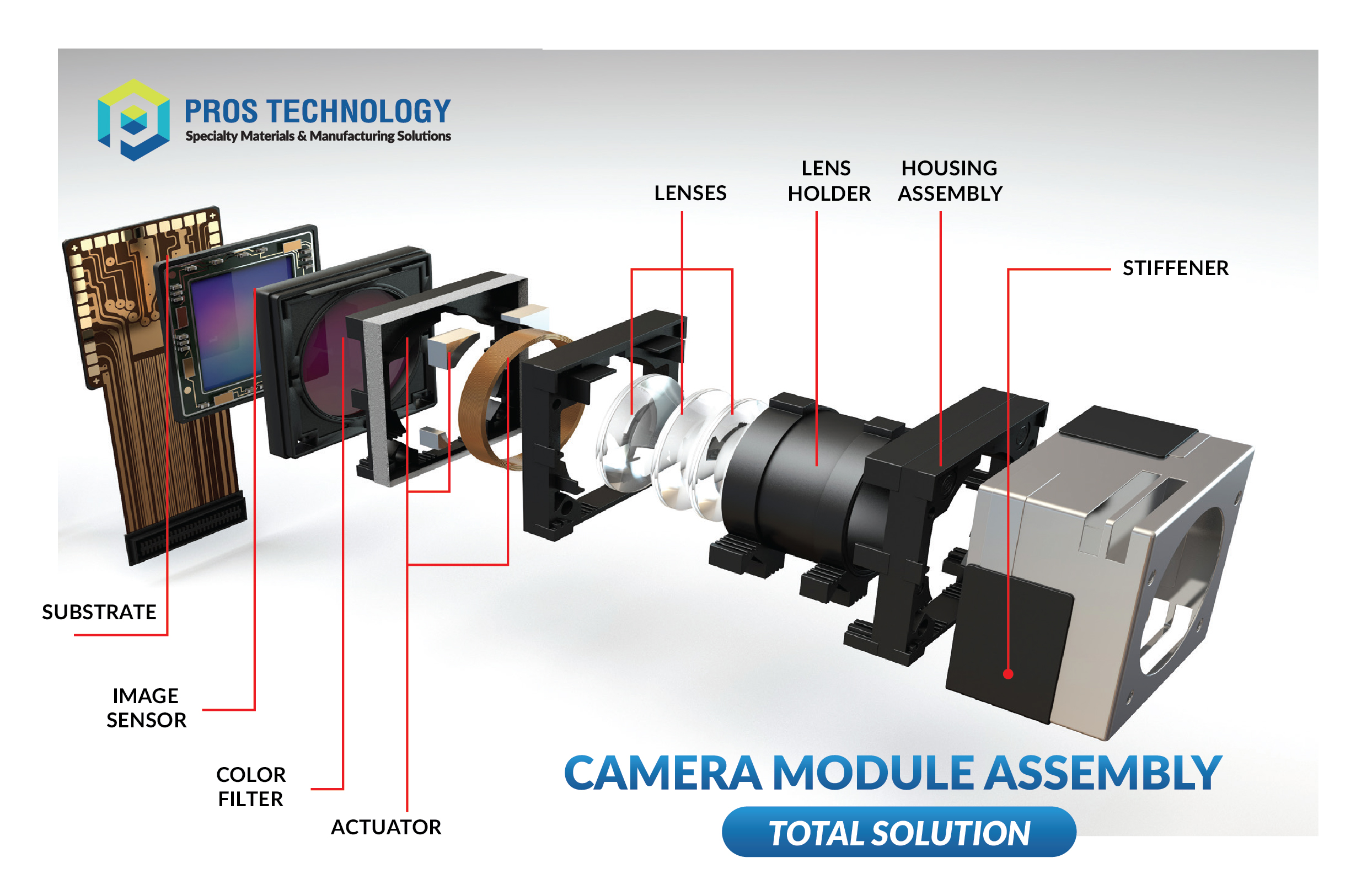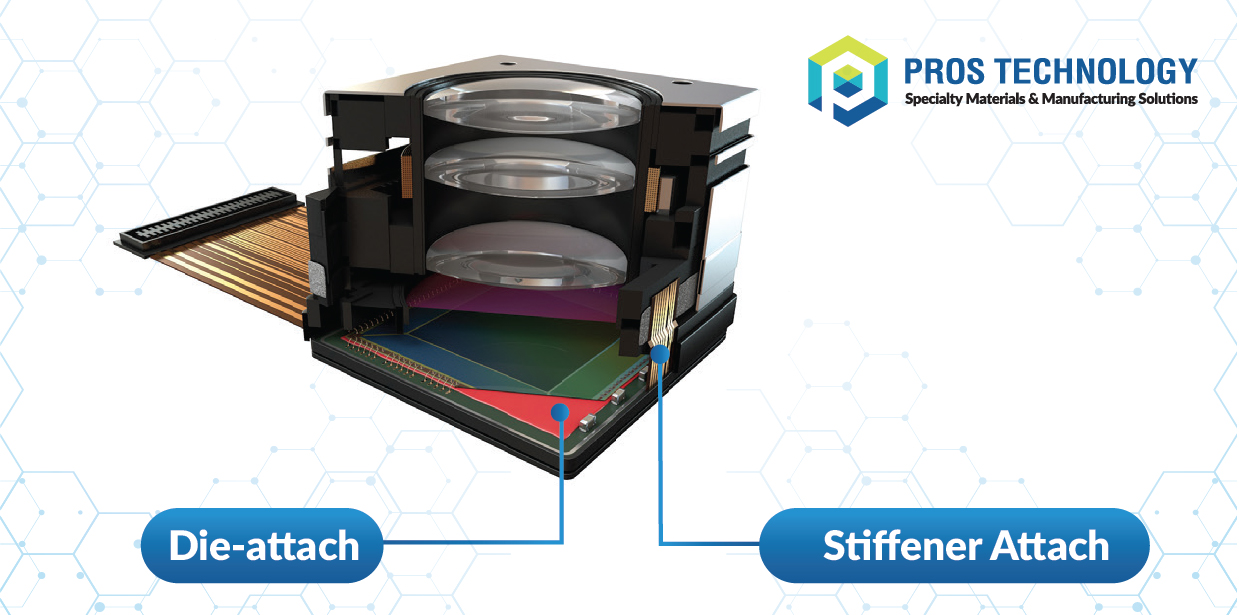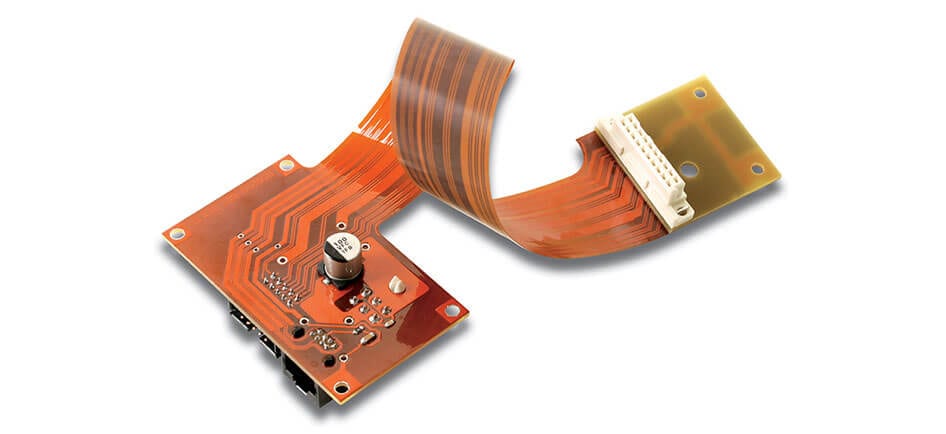For decades, the camera has commonly known as an indispensable device in high-tech equipment as smartphone, tablet, and laptop. However, due to the development of ADAS (Assistance Driver Advanced System) in the Automotive Industry, many companies are trying to improve the functionality of camera-based solutions, which plays the main role in the operation of future cars.
During the process of R&D, engineers could have troubles because of the number of components found in camera modules and the interdependence of each element on the other for proper function, PROSTECH would help to summarize some main applications in the camera module assembly process as following.

1. Die attach – Image sensor to substrate

| Application | Bonding image sensor to substrate |
| Surface Materials | FR4/ Ceramic/ Gold-plated PCBs |
| Challenges | Pixel counts are increasing => die sizes are getting larger => increasing warpage |
| Adhesive solutions | Heat-curing 1K Epoxy Adhesive |
| Features | ♦ Low-temperature cure (80°C) ♦ Low-stress die attach ♦ Low outgassing ♦ Faster cure (Improved throughput) ♦ Low halogen / RoHS-compliant |
2. Electrically Conductive Adhesive

| Application |
♦ Replace solder materials/ electrostatic discharge ♦ Bonding voice coil actuator to the spring ♦ Bottom-attach and side-sealing stiffener for ground bonding and fixturing |
| Solutions | Electrically Conductive Adhesives in Snap Cure and Oven Cure |
| Challenges | ♦ Good electrical conductivity ♦ Fast curing ♦ High and stable adhesion ♦ Low-temperature cure ♦ Long pot life ♦ Low halogen / RoHS-compliant |
3. Camera module main parts bonding adhesive
| Application | House Bonding | Lens Bonding: lens barrel to lens holder | IR Filter Bonding |
| Challenges | Pixel and lens quantity increase day by day | Accommodate low-temperature processing | Strong but flexibility bonding => high bonding strength but having ability to aborb stress |
| Adhesive Solutions | UV and thermal cure adhesive | UV cure on demand adhesive | UV Adhesive |
| Features | ♦ High adhesion to LCP, PA,PPA, etc. ♦ Low-temperature cure (80°C) ♦ Faster cure (Improved throughput) ♦ Dual cure (UV & thermal) ♦ Low halogen / RoHS-compliant |
||
4. Underfill Material
| Application | Flip-chip image die safeguard – side fill underfill |
| Challenges |
♦ Ensure bump reinforcement during reliability testing and while in use ♦ Control flow essential to material containment and to avoid image sensor contamination ♦ Protect connection of the camera module to the PCB |
| Adhesive solutions | 1K Epoxy – Underfill adhesive |
| Features | ♦ Controlled flow ♦ High thixotropic index ♦ Good bump coverage ♦ Good fillet capability ♦ Low-temperature cure ♦ Long pot life ♦ Low halogen / RoHS-compliant |
5. Detailed applications
| Application | Adhesive Solutions |
| Anchoring of flex board to the camera |
UV light-curing adhesives |
| Stiffener support plate to flex board | Low-temperature cure adhesive |
| Flex cable (FPC) to camera PCB | Flexible solutions and lower cost through liquid anisotropic adhesives |
| Image sensor to substrate | Heat-curing adhesives give high reliability in both COB die attach and flip-chip attach |
| Grounding | Fast dual-curing electrically conductive adhesives allow fast preliminary UV/ light fixation |
| IR filter to substrate | Fast-curing and light-blocking adhesive are designed for the best drop test performance |
| Retainer ring replacement | Black dual-curing adhesive with fast UV/ light fixation and heat curing at low temperature |
| Lens barrel to VCM holder bonding | Fast dual-curing adhesives with UV/ light fixation and high drop test sustainability |
| Contacting the wires of VCM to board | Adhesives with good electrical contact and adhesion to gold. Low-temperature curing to protect the optical coating |
| Housing bonding by active alignment | Fast preliminary UV/light fixation for high-precision placement of housing |
For FREE CONSULTANT, please contact us through hotline or filling the form above
Email: gluexpert@prostech.ph
Hotline: (+84) 984 695 398







